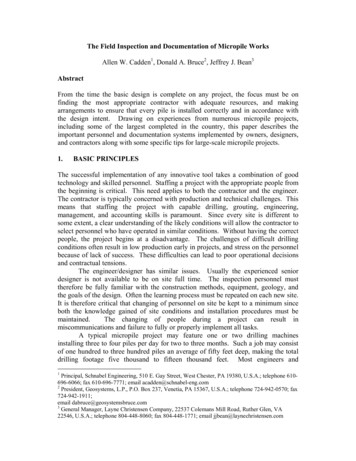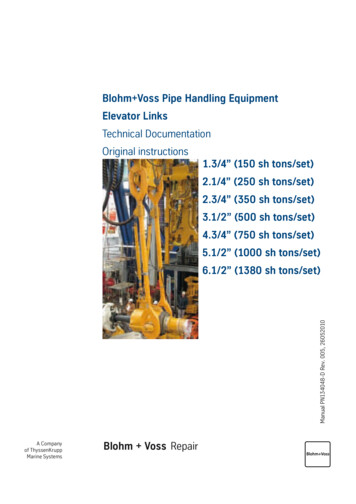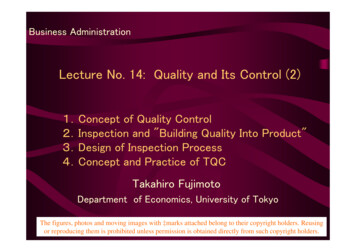
Transcription
The Field Inspection and Documentation of Micropile WorksAllen W. Cadden1, Donald A. Bruce2, Jeffrey J. Bean3AbstractFrom the time the basic design is complete on any project, the focus must be onfinding the most appropriate contractor with adequate resources, and makingarrangements to ensure that every pile is installed correctly and in accordance withthe design intent. Drawing on experiences from numerous micropile projects,including some of the largest completed in the country, this paper describes theimportant personnel and documentation systems implemented by owners, designers,and contractors along with some specific tips for large-scale micropile projects.1.BASIC PRINCIPLESThe successful implementation of any innovative tool takes a combination of goodtechnology and skilled personnel. Staffing a project with the appropriate people fromthe beginning is critical. This need applies to both the contractor and the engineer.The contractor is typically concerned with production and technical challenges. Thismeans that staffing the project with capable drilling, grouting, engineering,management, and accounting skills is paramount. Since every site is different tosome extent, a clear understanding of the likely conditions will allow the contractor toselect personnel who have operated in similar conditions. Without having the correctpeople, the project begins at a disadvantage. The challenges of difficult drillingconditions often result in low production early in projects, and stress on the personnelbecause of lack of success. These difficulties can lead to poor operational decisionsand contractual tensions.The engineer/designer has similar issues. Usually the experienced seniordesigner is not available to be on site full time. The inspection personnel musttherefore be fully familiar with the construction methods, equipment, geology, andthe goals of the design. Often the learning process must be repeated on each new site.It is therefore critical that changing of personnel on site be kept to a minimum sinceboth the knowledge gained of site conditions and installation procedures must bemaintained.The changing of people during a project can result inmiscommunications and failure to fully or properly implement all tasks.A typical micropile project may feature one or two drilling machinesinstalling three to four piles per day for two to three months. Such a job may consistof one hundred to three hundred piles an average of fifty feet deep, making the totaldrilling footage five thousand to fifteen thousand feet. Most engineers and1Principal, Schnabel Engineering, 510 E. Gay Street, West Chester, PA 19380, U.S.A.; telephone 610696-6066; fax 610-696-7771; email acadden@schnabel-eng.com2President, Geosystems, L.P., P.O. Box 237, Venetia, PA 15367, U.S.A.; telephone 724-942-0570; fax724-942-1911;email dabruce@geosystemsbruce.com3General Manager, Layne Christensen Company, 22537 Colemans Mill Road, Ruther Glen, VA22546, U.S.A.; telephone 804-448-8060; fax 804-448-1771; email jjbean@laynechristensen.com
contractors have been associated with these types of projects wherein the contractorplaces a seasoned superintendent and possibly an engineer on the site and theengineer may provide an inspector for each machine. The engineer will also recorddata for drilling and grouting, and verify the contractor’s compliance with thespecification and the method statement. These projects maintain work schedules ofsingle-shifts for eight to twelve hours per day over five to six days per week. Themaintenance of six to eight drill logs per day is by no means an inordinate task.There are frequently problems associated with unanticipated buried obstructions or apile slightly out of tolerance, but the contractor will move to another footing pendingredesign of the former, and contractual resolution of the latter.Figure 1. Intense micropile construction site, with multiple rigs working24 hours per dayThe dynamics of the project change however when the task is to install onethousand five hundred piles or sixty-five thousand feet in eight weeks as wasexperienced by the authors in a large project recently. Comparing this actual projectto the “typical” smaller project outlined above, two machines working a single-shiftbecame five machines working around the clock six days per week (Figure 1). Threeto four piles per day became thirty to forty, and the average daily productionexceeded two thousand feet. The contractor’s on-site personnel increased from eightor ten people to over fifty, and the engineering oversight increased from two to overten people.The same process for setting up the work is employed for both large and smallprojects, but obviously the number of people involved increases dramatically as doesthe required level of focus on details. The owner, designer, and contractor mustrealize this at the onset. This needs to be fully described in the proposal phase andnormally is, as the owner wants it clearly demonstrated that the successful offeror hasthe adequate manpower to handle the work. Often, however, the level of fieldsupport from the designer is not so clearly defined until the start of construction, and
this can lead to difficulties in staffing and training the inspection personnel on shortnotice.To coordinate this for all parties, the first step is to define an organizationalchart (Figure 2) clearly indicating personnel, job function, and chain of command.This should be developed during design or at the latest during the constructionproposal development so that all parties recognize the level of effort that is expectedof them. Résumés for specialty subcontractor individuals should be submitted withtheir proposal indicating their ability to support the organizational chart. Résumésfrom key management personnel to craft labor should be requested: operators whorun the drills, grouting equipment, and load tests are integral to the project success.OwnerDesign TeamType title hereStructural EngineerGeotechnical EngineerConstruction Mgr.General ContractorOther DesignersMicropileSubcontractorSpecial ConsultantMaterials TestingInspectorSupport Inspectorsand EngineersDrilling and Pileconstruction (3-5)OtherSubcontractorsConsulting EngineerField Sr. EngineerSr. InspectorDay ShiftSafety OfficerSite EngineerQA/QCEngineeringAssistantSr. InspectorNight ShiftMaterials TestingInspectorSupport Inspectorsand EngineersDrilling and Pileconstruction ing/Site ors (4)Dockbuilders(4)Drill Operators(6)Mixer/Laborers(2)CompressorPump Operators(2)Dockbuilders(10)Dockbuilders(2)Figure 2. Typical project organization chart for a major project.In summary, the successful and high quality implementation of a micropileproject begins in the field with the selection of properly trained and experiencedpersonnel, and with a clear, logical, and functional organization. This applies equallyto the owner’s representatives and inspection staff as to the contractor’s personnel.2.THE DUTIES AND RESPONSIBILITIES OF THE CONTRACTOR2.1Functions and Duties of the IndividualsOn any project, the precise duties and responsibilities of the respective parties mustbe clearly identified. The following discussion provides a generic view, applicable toa major, fast track project.The personnel organization chart is the baseline for the project, although itmay not be very specific regarding the individual responsibilities of the functions andpositions. The following is an outline of the roles envisioned for each of thecontractor’s personnel: Project Manager: has complete responsibility for project and often becomes fulltime site manager, and can negotiate with the owner’s or construction manager’s
representative with respect to all aspects of the job. On a very large project, thisperson probably has senior corporate responsibilities. Engineering Design: personnel supporting the project from the contractor’s homeoffice or may be from a subconsultant. They will make site visits depending onthe level of engineering or design required by the contractor, or the frequency ofsignificant changes. Safety Officer: is responsible for contractor’s overall compliance with safetyprocedures. This individual provides on-site support as required. The SafetyOfficer has authority independent of the Project Manager. He may not beresident.Site Engineer: provides project management with operational and technicalsupport; directs QA/QC efforts and sets up testing procedures and schedules; andaids in directing engineering assistants with regard to data collection and entryinto spreadsheets and logs. Engineering Assistants: support QA/QC efforts. They become the clearinghousefor all contractor-generated data on a daily basis. These data include those fromtesting, drillers’ reports, grouting reports, and surveys. They will interface withinspection personnel in reviewing and preparing as-built data for submission tothe owner. They will coordinate survey and layout information and develop asbuilt drawings. Superintendent: directs the work force and ensures quality compliance withspecifications; coordinates daily work activities with construction manager andother site contractors; submits daily reports which act as, or supplement, the jobdiary and contain a description of the day’s completed work along with theassociated equipment, manpower, and materials consumptions; and inspectmaterial shipments for quality compliance upon delivery. Drilling/Grouting/Site Foreman: take direction from the superintendent and assistin completing the daily reports by collecting information from the operators.Their function is to expedite and facilitate the completion of the work. Drill Operators and Grout Batch Plant Operators: are the main equipmentoperators and the heart and soul of the construction operation. After the proposal,submittals, and work plans are all approved, the operators will determine howsafely and with what speed and quality the finished product is actually delivered.Equipment operators will provide the logs for the holes to the rig inspector tosubmit with their reports. Experienced operators are required to maximizeproduction in difficult drilling environments.The recent major project personnel for the contractor all had prior large jobexperience and were not new to detailed recordkeeping on construction-orientedprojects of this nature. On-the-job training of personnel with so many piles to installwas not an option. Where such staffing is not feasible, it is imperative that themanagement and several of the key field supervisory personnel have similarexperience and will make time to train each of the remaining personnel on theintricacies of data management on a large project.
2.2Outside Review and Work PlanOften the contractor will employ the services of an independent consultant even if thepile design responsibility is the owner’s responsibility. This additional peer review isan additional set of eyes for complicated projects. The consultant will review thecontractor’s work plan, witness test pile installations, actual testing and conductperiodic observation of production work. This independent review will help bridgethe gap between the contractor and the owner’s technical design and oversight, thusaiding the overall smooth running of the project.Where the project is for a private entity, there may be some allowance forsubmittal and document review to begin prior to award, as a part of the best valueevaluation by the owner, rather than basing the selection solely on low bid. Tocomplete this, the contractor will submit with his bid a detailed work plan. The workplan is specific as to the types and sourcing of materials and equipment planned forthe work. An outline of the proposed installation techniques for drilling and groutingthe piles is included along with a man-hour loaded schedule for the project’s duration.Furthermore, issues such as spoil management, QA/QC measures, including piletesting procedures and sequence, grout testing and monitoring, material certificationsand project recordkeeping should be included in the submittal. All of this informationcoupled possibly with a detailed personal interview before award affords the owner and engineer - an opportunity to thoroughly review of the contractor’s proposed scopeof work and commercial conditions.2.3Data Management2.3.1 Survey and LayoutThe contractor may be obliged to employ a licensed surveyor to assist in making surethe piles are correctly located. The surveyor relies on benchmarks provided by theowner to establish control. Each pile is numbered sequentially and a base map isproduced. This greatly facilitates pile identification in the field.A separate spreadsheet is maintained with all of the piles listed by referencenumber along with their corresponding North and East coordinates, cutoff elevation,and location by building column line references. During the project, pile locationsmay be changed due to redesign, and the base map must be modified accordingly andupdated. The details that may be contained in a management table are shown inTable 1.Table 1. Information typically included in a pile “management table.”PLANNED CONSTRUCTIONPile NumberLocation NorthingLocation n NorthingLocation EastingOffset from design locationDrilled lengthLength of soil
PLANNED CONSTRUCTIONPlanned LengthDesign Bond LengthPile Reinforcing DetailsPile Top DetailAS-BUILTLength of rockRedrill lengthBond lengthReinforcing installedGrout volume placedRegrouting volumePile layout in the field on large and congested sites can be accomplishedprimarily with GPS. This works well when direct line of sight is not always availabledue to the number of drills and other construction equipment. Wood stakes withfluorescent orange flags and the pile number written on it are first used to stakelocations; however, as the site becomes increasingly trafficked stakes are lost. Metalspikes driven flush into the crushed stone working surface with flagging was usedeffectively on this recent project.A different surveyor can be employed by the contractor to provide as-builtpile coordinates for each completed pile. These pile locations, along with final cutoffelevation for the casing and bar should be determined within forty-eight hours after apile is completed. The contractor can then enter this asbuilt data into the spreadsheetcontaining the design pile coordinates and the offset distance can be calculated.Typically these data are then emailed to the construction manager for submission tothe structural engineer for review, and evaluation of whether the actual as-built pilelocations are satisfactory. The entire process from obtaining as-built data to the finalreview by the structural engineer may take about two days. Such quick turnaround ofdata is imperative when pile caps are to be formed and poured immediately behindpile drilling.It is preferable to use two independent groups of surveyors for two reasons.One is for quality control purposes as the as-built surveyor is independent of thelayout. The second is simply that the workload can be too much for one company tohandle: a single company may not possess the resources to handle all of the work on alarge, fast-moving project.2.3.2Pile Installation DataThe specifications, contractor’s method statement submittal, and test program aretypically merged together to form a baseline for subsequent production pileinstallation. Grout quality and consistency is typically indicated by specific gravitytesting (when fluid, prior to placement) and by cubes, for later strength testing. Abatch plant set on electronic load cells accurately measures cement and water byweight for every batch of cement mixed. Grout testing may be performed bypersonnel from an independent local laboratory working under the direction of thedesign engineer, or can be conducted by the contractor himself.Data collection at the pile location becomes a collaborative effort between thecontractor, engineer, and independent materials testing laboratory. A dedicatedinspector on each drill can accurately record the work and collect geotechnical dataduring drilling. The basic principles of Measurement While Drilling (MWD) should
be applied focusing on quantitative measures such as rate of penetration, as well asmaterial descriptions inferred from drill performance or cuttings (Bruce, 2003).Based on this, the inspector can provide instruction to the driller as to where toterminate overburden casings and rock socket drilling in an owner-controlled piledesign project. The contractor provides a basic drill log of the hole with associatedcasing lengths and reinforcing bar.The grouting records collected separately is then married to the drilling log atthe end of each day to complete each micropile log.The timely upkeep and maintenance of the pile construction as-built data is atask that must be implemented (Table 2) at the beginning and maintained daily. Thecontractor’s site engineer collects the drillers’ reports and grouting reports daily, andthe data are entered into an as-built spreadsheet. The owner’s engineer will usuallycomplete a duplicate from the data collected by the inspectors. The contractor andengineer must verify quantities daily to maintain accurate documentation for bothparties. The consensus spreadsheet should be submitted to the construction managerweekly.2.3.3Pile CorrectionsThere are sometimes circumstances where pile construction does not meet thestandard of quality required. For example, tooling and/or casing may become lodgedin the hole, or grouting problems may occur or installation may become impossible orimpractical due to a differing site condition. Occasionally, a pile may just have beenlocated incorrectly or installed to the wrong depth. The key is to review siteprocesses when errors do occur so that such errors or non-compliances are notrepeated. Redesign may allow the use of a “wrong” pile by modifying a pile cap orinstallation of a “sister” pile as a supplemental element. The rate of defective piles isnormally less than 1% with, of course, the goal being zero.3.THE DUTIES AND RESPONSIBILITIES OF THE OWNER’SENGINEERThe organization chart (Figure 2) depicts the level of effort for a large project for theengineering/design side. Recognizing that the engineer has a basic need for datacollection and recordkeeping is only a step in the documentation effort. The overallgoal of the engineer’s representative on site is that of confirming the assumptionsmade during design, and verifying that the owner is receiving the product for whichhe contracted.Similar to the roles defined for the contractor’s personnel, the following is abrief description of the roles for the owner’s field representatives:Sr. Engineer: must have a complete understanding of the geologic conditions andassumptions, the pile design requirements, expectations for drilling conditions and rigperformance, grouting process, and an overall awareness for the unexpected. TheSenior Engineer has complete responsibility to manage the field staff, make fieldjudgment calls that do not change the basis of design, review all documentation, andreport to the Engineer of Record.
Table 2. As-built survey table
Senior Inspector: leader of the field crew and is responsible for ensuring adequatetraining and understanding of the particular tasks that the individual inspectors areassigned is in place; provides response to minor clarification or interpretation of itemssuch as adequate bond material; collects daily field records and ensures completenessand accuracy before turning the paperwork over to the Senior Engineer for review. Inspectors: independent data collection and documentation of field activities andas-built conditions for every foundation element, must understand the design andconstruction expectations for the task being monitored.The representatives in the field serve as eyes and ears for the more seniordesigners in the office. As such, they must have the ability to understand the design,site assumptions, and construction process. With a small project, this ability istypically carried in one person. On a large project, this can be a sizeable cadre ofpersonnel, which adds complication of personnel, data, and paperwork managementto the duties of the senior representatives.Often, the most experienced field inspection personnel may not possess thevariety of skills necessary to understand design, construction, schedule and personnelmanagement, recordkeeping, and organization. Careful selection is required toidentify those with sufficient skills to fill the positions in the organization chart.Improper selection often creates significant difficulties as designers and replacementpersonnel have to back track and recreate records from sketchy notes.Most of the key elements important to the engineer are exactly the same asthose identified above for the contractor. This is a good scenario because the contractis setup based on the contractor achieving the key elements of the project, those thatare fundamental to the design intent and details. Some related considerations are: The pile numbering scheme established at the beginning of the project should beeasily recognized by all field and office personnel since everyone will have tocommunicate in the numbering language throughout the project. These numbersshould be logical based on site and building layout (e.g., start at a corner and workclockwise or utilize the architect’s column numbering scheme in some form).This logic will allow everyone to quickly find the location on a plan, or tovisualize the site remotely from the head office when issues arise in the field. Survey references are critical; these must be protected and accurate. Efforts spentat the beginning of the project to make these as accurate and permanent aspossible are invaluable. They must also be accessible throughout the project. All drilling processes require careful observation and recording. With micropileinstallation, this is the key element for the confirmation of geologic conditions.The equipment used is very powerful and will penetrate quickly through mostgeologic conditions. As such, it take experience on the part of the inspector tounderstand how the drill and tooling works, what controls the driller exerts on theadvancement process, and what valuable feedback the ground can provide. Acontrol pile program should be completed where the inspection personnel canwitness installation of piles and gain an understanding of the process as itcompares to results depicted in nearby test boring logs. Subsequently, loadtesting of some of these piles will be used to confirm these observations andestablish the baseline drilling program for the project.
The grout is mixed on site. Although the mix is usually relatively simple (i.e.,just cement and water), minor variations can have a significant impact on theplacement process or performance of the pile. Micropile construction requires astable cement-based grout. When the grout is too viscous, it is difficult to pump.When it has an excessive w:c ratio the strength is compromised, and bleeding andshrinkage of the grout increases. Simple tests, primarily the Baroid mud balance,and often the flow cone (Chuaqui and Bruce, 2003), are the best methods forconfirming the quality of the grout before it is paced in a pile. Obviously, thecompressive strength tests are not available until well after the pile is constructedand on a fast track project, often the pile cap is in place before strength testing iscomplete. Furthermore, experience with cement grouts has shown that thecompressive strength tests do more to confirm the ability of the technician tomake cubes than they serve as a reliable quality control tool. Field documentation is the key to relaying the information back to the designersin the office. Most engineers have standard forms for recordkeeping. It isprudent to review these forms and modify them if needed so that all of therequired project specific information will be recorded. Field personnel should beobliged to fill in all lines on every form provided, every day, since they are oftentempted to skip areas they feel are unnecessary. This will result in a loss of dataand inability to thoroughly understand the project upon later review. A standardform with unnecessary blanks warrants modification, however. Summary documents should also be efficient. Where spreadsheets are created tomanage large amounts of data, efforts should be made to set these up so that theinformation is easily entered and compared to key metrics. Metrics are oftenrelated to design issues, but should also consider contracting issues between theowner and the contractor. Often, fields can be set up with conditional formattingto provide flags when data fall out of an acceptable range. This will make thereview of the information more efficient (Table 3). The role of the designer and field inspection staff is clearly not restricted to datacollection. Their experience and understanding of the project engineering issuescan help identify problems before they happen and prevent errors inreinforcement placement, grouting, or layout from occurring. The understandingand attention to detail coupled with some available free time to observe conditionsbetween recordkeeping events can be an asset to the contractor’s personnel whoare often under extreme pressure to meet schedule and prevent damage toequipment, and who may be tired and less attentive at times.The flow of data and confirmation of information between the field inspectionstaff and the contractor was described in Section 2.3 above. This must occur in realtime so that the inspection reports can be delivered to the engineer for review. Aregular reporting or summary should be provided then from the engineer to the ownerand possibly the construction manager. This serves two purposes. First, it is averification tool for the owner when reviewing contractor submittals and payrequests. Second, it is a tool for the engineer to ensure that there is a timely review ofthe information. The timing of these reports should be established at the beginning ofthe project based on these two needs.
Table 3. Typical pile data summary spreadsheet
4.PROJECT STARTUPThere is typically a “ramp-up” phase during which the contractor, engineer,construction manager, and owner are individually and together field commissioningtheir respective systems. This allows valuable time to debug procedures such as thetesting, sampling, production, data collection and reporting, and inspection. Theconstruction manager in particular must allow time for his personnel to becomeacquainted with the specialty nature of micropile installation especially when they areproviding concurrent work services which may interfere with the micropile operation,e.g., site excavation and access, utility relocation, water, electric, and lay downrestrictions.Often projects call for several “disposable” piles, successful piles load testedprior to production pile construction. On projects with particularly tight schedules, itis frequently agreed that production pile installation may start in areas of the sitewhere a single load test has been successfully completed. This permits the productionwork to start sooner and with fewer men and pieces of equipment. This also permitsall of the parties to develop a familiarity with the work and to refine proceduresduring this “honeymoon” phase. Furthermore, the crews and inspectors can becomecomfortable with the particular geologic condition and the drilling and groutingparameters, before moving into other areas where construction procedures may needto be varied as each representative load test is completed. As a result, the contractoris able to accelerate by working with a smaller crew on single shifts. Later, whenmore intense work begins, the production curve can be expected to be much steeperthan what might have normally been expected by starting with full crews in multiplevariable conditions.Once these procedures are in place, providing the owner with a product ofacceptable quality becomes simply 1) locating the pile correctly, 2) drilling the pileaccording to the established procedures and collecting the data, 3) placing the correctlengths and amounts of materials, and 4) correcting any problems if one of the firstthree are not met. Significant effort should be placed on establishing baselinecontrols, tracking the production data, and comparing it back to the baselines toassure all processes are in compliance.5.THE VALUE OF COMMUNICATION AS A QUALITY TOOLThis paper refers in depth to recordkeeping and data management on a micropileproject. Large projects or small, this is a key issue and the first step in overall projectcommunications. Wherever possible, this information should be freely shared andconfirmed between parties on a regular basis. Conflicting data discovered late in theproject are often difficult to reconcile, and can become a severe point of contentionbetween parties often affecting payment requests.A second component to the required communication flow on a project isregular meetings. These should occur on several levels. At the highest level, a seniorrepresentative from the owner, construction manager, contractor, and engineer shouldmeet regularly (say weekly) to review the overall progress of the project, plan futurework, discuss issues that may not be clear for future work, and issues outstanding
from completed work. Below this level, regular communication should occurinvolving daily data review. A third level is within each group (engineer,construction manager, and contractor) where the field personnel are briefed on plansfor future work, issues that may be occurring in the data collection and reconciliation,and any changes in design and construction processes. There will also b
the design intent. Drawing on experiences from numerous micropile projects, including some of the largest completed in the country, this paper describes the important personnel and documentation systems implemented by owners, designers, and contractors along with some specific tips for large-scale micropile projects. 1. BASIC PRINCIPLES











